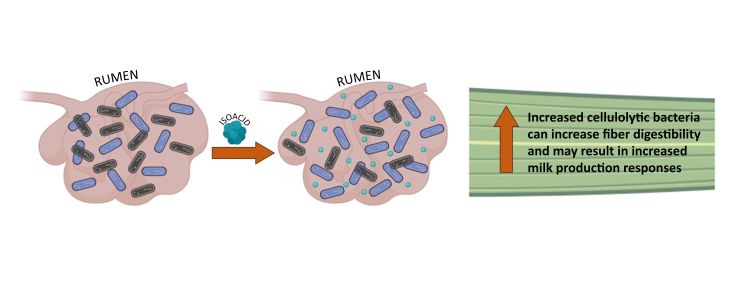
Source: Michigan State University, Alycia Bales
Isoacids have drawn renewed interest as a dietary supplement for dairy cattle to improve fiber digestion, potentially resulting in increased milk production.

Isoacids role in rumen function has been studied since the 1950s but they have recently gained more interest from researchers. An isoacid is a chemical produced from the degradation (breakdown) of amino acids in the rumen. Early research on these isoacids indicated an improvement in rumen function and production efficiency of the dairy cow when added to the diet. Learning the mechanisms involved and results of supplementing isoacids to dairy cattle, as well as their application in industry and how they can be applied can potentially increase a farm’s profitability.
To understand the “how” around isoacids improving milk production performance, we first must look into the rumen. Maximizing digestion and absorption within the rumen can help optimize productivity of the dairy cow. The rumen contains an ecosystem including thousands of species of protozoa and bacteria which contribute to the production of energy utilized by the cow for maintenance and milk production. Rumen bacteria are commonly divided into two categories: cellulolytic bacteria, which digest fiber and amylolytic bacteria, which digest starch and sugar. Isoacids are naturally produced in the rumen through digestion of protein and are required by cellulolytic bacteria for growth, so maintaining optimal concentrations of isoacids can enhance the growth and activity of cellulolytic bacteria and improve fiber digestion. Increasing fiber digestion can increase the nutrients produced in the rumen that are used for creating milk fat, thus there is a potential to positively impact milk fat yield. Isoacids have also been found to influence hormones associated with the nutrient utilization for milk production, which can improve efficiency of the mammary gland.
In several studies conducted over the years, supplementation of isoacids has resulted in varying effects for dry matter intake (DMI), thus the increased milk production observed could be due to an increase in DMI or lack of a DMI response resulting in a more efficient animal. This finding for DMI is important, as feed is the largest expense on a dairy farm. There have been some reports of an increase in DMI, which improved production of milk components. The addition of isoacids has increased milk components yield, thus increasing milk revenue. In cases where low forage, high concentrate diets induced milk fat depression, supplementation of isoacids helped alleviate this loss of milk fat. Going back to the first field trials using isoacid products, most cows receiving a form of isoacid supplementation (multiple isoacids or a select few) have shown improvements in milk performance parameters, especially milk solids yield. Most of these responses in production, especially with increases in milk fat, can be attributed to the positive influence of isoacids on fiber digestion in the rumen, allowing efficient utilization of nutrients. However, there were a few studies that did not observe improvements in fiber digestion or milk production, so it’s important to consider that not all cows will respond to isoacid supplementation.
Incorporation of isoacids into dairy cow diets may improve milk production performance, but it can take time to see results. Producers wanting to invest in an isoacid supplement may wait three weeks or more for a measurable boost in milk component output. Production improvements may be more dramatic when isoacids are added to diets with low forage content, as the isoacid supplementation may help to overcome poor fiber digestion in these situations. As with all supplements, profitability is the main driver of supplement use, and minor increases in milk component yields may not overcome the cost associated with the incorporation of an isoacid product in a diet. However, the potential for an isoacid product to improve efficiency of lactation of today’s dairy cow should spark discussions between dairy producers and nutritionists.







